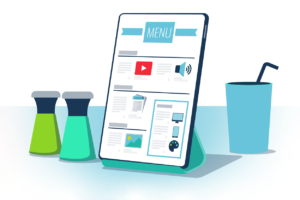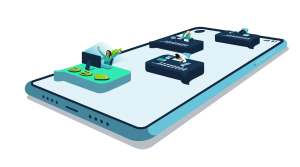As we move further into the digital age, it’s become clear that the human attention span is decreasing rapidly. In fact, at the beginning of the millennium, the average attention span was around 12 seconds. Fast forward to now and the average attention span lasts just eight seconds.
We’re struggling to focus on single tasks for long periods of time. We have a tendency to get distra… oh, look at that dog!
When we’re online, we’re exposed to an overload of information. In the past that’s also often been our approach to training. We would create a comprehensive training module and bombard the learner with everything they need to know.
However, this simply isn’t effective. Learners struggle to concentrate on such a mass of information. We need another approach that makes information easier to consume and absorb. Enter microlearning.
Microlearning is quickly becoming modern learners’ favourite way to build their knowledge. But why? We’ve got the answers! In this article, we’ll run through what microlearning really is and it’s many benefits. Let’s get going!
What is Microlearning?
 Microlearning breaks learning content down into bite-sized pieces instead of large chunks. It’s often much more effective to split everything up into small, focused bursts. The length of a typical microlearning intervention is between two and five minutes. Short and snappy!
Microlearning breaks learning content down into bite-sized pieces instead of large chunks. It’s often much more effective to split everything up into small, focused bursts. The length of a typical microlearning intervention is between two and five minutes. Short and snappy!
This content can be completed within just a few minutes and has been found to improve learning efficiency by 17%. Big change often comes in small packages.
Additionally, when you’re running a training programme you’re bound to discover that your target audience tends to be very busy. In fact, employees only have about 1% of their workweek to complete training. That translates to a worrying 5 minutes per day.
As such, asking your team to take time from their work to learn can be a challenge. However, if you break content up into small, digestible chunks, it’s a much easier pill to swallow.
The History of Microlearning
Microlearning has been around (in practice) for as long as human beings have been learning. It could be argued that the first caveman to strike two rocks together to create fire was undergoing a microlearning experience. However, the use of the term ‘microlearning’ and its rise in popularity is a relatively new thing.
Some believe that the first published use of the term dates back to 1963, in a book called ‘The Economics of Human Resources’ by Hector Correa. Others suggest that the term was coined in 2003 by Research Studios Austria.
Whatever the case, microlearning has been around for a while. It started to really gain traction in the 1990s with the increased spread of the internet and the popularisation of eLearning.
These days, microlearning is the preferred way to learn due to the prevalence of smartphones. It’s all too easy to complete simple learning tasks on our mobile devices. In fact, the global microlearning market was valued at $1.59 billion in 2020 and is projected to reach $4.04 billion by 2028.
Microlearning is perfect for today’s learners because they’re always on the go. Furthermore, they always have access to a device they can view their training on. This means they can complete it on their commute, their lunch break and more. Consequently, microlearning has been shown to increase engagement by 50%.
How Does Microlearning Work?

Microlearning involves creating small pieces of content, which can be completed in a short time as and when the learner gets a chance. As learners work their way through a number of these ‘microunits’ or short learning experiences, behavioural change will develop.
Microlearning reframes existing content into focused learning events with simple, achievable goals. In fact, typical microlearning interventions only seek to achieve a single learning objective.
The neuroscience behind microlearning helps to explain why it works so well. It uses the cognitive skills learning system in our brain. This system relies on the prefrontal cortex. This is the main system in your brain for learning skills and helping with short-term memory.
If microlearning is combined with well-thought out content, it’s converted from short-term memory in the prefrontal cortex to long-term memory in the hippocampus.
Space it Out
The use of spaced repetition is also key here. Spaced repetition leverages the memory phenomenon known as the spacing effect. This effect is based on research that suggests we learn better when content is spaced out, rather than delivered in one fell swoop.
Microlearning makes it easier for content creators to produce more learning objects and deliver them in a campaign-style format. It also helps to combat the Forgetting Curve. This theory suggests that we forget 90% of the information we learn within a week. Finding a good solution to this problem is a major step forward.
Spaced repetition helps to combat the curve. After all, each learning intervention provides a new opportunity to practice active recall and to build upon a foundation that you’ve already established. This boosts memory retention.
In fact, a study has shown that when spaced repetition was used, it improved retention by 800%. Think of those flashcards you made for an exam. You created small pieces of content and looked at them over and over again until they were ingrained in your memory!
It’s the same thing with microlearning. Due to its format, it means that content is easy to remember and consume again when needed.
Microlearning Applications
Microlearning is a natural match for a number of other types of learning. Here’s a few ways you can maximise its effects:
Mobile Learning
![]() Somewhat confusingly, mLearning doesn’t refer to microlearning, but rather mobile learning. That being said, the two are actually a perfect fit for each other.
Somewhat confusingly, mLearning doesn’t refer to microlearning, but rather mobile learning. That being said, the two are actually a perfect fit for each other.
When delivering training via a mobile device you have a number of limitations to consider, such as poor connectivity and small screen sizes. Therefore, short snippets of content are exactly what the medium needs.
This is where a mobile app solution gets its chance to shine. With these, microunits can be completed on the go and won’t use up all of your learners’ mobile data!
Learners can even download these microunits to be used when they have no internet connection at all. Once back online, your app solution will synchronise the results of any completed units.
The harmony between mLearning and microlearning is a big reason why the mobile learning market has an annual growth rate of 23%.
Just-In-Time Learning
![]() One of the biggest benefits of microlearning is that it can be completed in a flash. For this reason, it’s a fantastic way to deliver just-in-time learning!
One of the biggest benefits of microlearning is that it can be completed in a flash. For this reason, it’s a fantastic way to deliver just-in-time learning!
Just-in-time learning means having access to knowledge whenever you need it. As it’s delivered at the point of need, learners should be able to find and complete it there and then.
This means that they won’t have to find an hour to work through in-depth learning content. Instead, having a small piece of content will give them a quick refresher, which they can then put into practice right away.
Adaptive Learning
![]()
Adaptive learning is a clever branch of personalised learning, where a training programme is automatically tailored to suit the learner. For example, a learner might complete an eLearning unit. Based on their performance, the LMS could automatically push recommended content to them. This is facilitated a lot easier these days by AI-powered learning platforms.
The original unit should have done a good job at covering the topic in general, so another comprehensive unit is likely to be unnecessary. Instead, microlearning units are a great way to plug these knowledge gaps.
With a content authoring tool, you can create short learning interventions focused on the area that the learner struggled with. This personalised, adaptive and rapid approach makes learners more likely to feel motivated to complete extra training. After all, 58% of employees say they’d be more likely to do online training if the content was broken into smaller chunks.
Now let’s take a look at a few of the benefits of microlearning!
Benefits of Microlearning
1. Different Media Formats

Microlearning allows you to take advantage of a variety of different media formats. These days, learning comes in many forms ranging from video, podcasts, visuals and more.
This is exactly the kind of content that a modern learner likes to engage with. For example, did you know that 61% of teachers believe that students prefer to learn via video?
With microlearning, you can craft learning experiences based on any relevant assets. For instance, you could include a two minute video, a well-designed infographic or a short podcast snippet.
In fact, 83% of learning takes place visually, so alternatives to text-heavy documents are bound to work well. Something that’s easily consumable within two-to-five minutes is sure to keep your learners engaged.
2. It Reduces Stress

When you have a lot of things to do or content to cover, it can become overwhelming. When you feel stressed, your brain releases a hormone called cortisol.
High levels of cortisol can negatively impact your memory, processing speed and social cognition. Businesses lose up to $300 million a year to workplace stress and 83% of workers say that they suffer from it.
By breaking content down into short and easily consumable units, it makes learning feel less daunting. This makes consuming training content less stressful. In turn, this reduces cognitive overload and increases knowledge retention. Nice!
3. It Improves Productivity
As previously mentioned, learners are very busy. It’s difficult for them to find time to consume lengthy, or overly detailed content.

If your training materials are too long, they may start to take away from other work and cause disengagement. Unfortunately, a shocking 51% of employees are disengaged in the workplace. This has a big impact.
According to Gallup, disengaged employees have:
- 37% higher absenteeism.
- 18% lower productivity.
- 15% lower profitability.
But what does that mean in financial terms? Each disengaged employee costs a business just over a third of their salary (34%). That’s $3,400 for every $10,000 they make. Ouch.
However, microlearning usually lasts five minutes or less. Thus, learners are able to maintain productivity and get a comprehensive learning experience. That’s why 94% of experts favour microlearning over traditional learning.
4. It Blends Well with Social Learning
Social learning is ‘the active process of learning from our observations and interactions with others’. It’s an informal learning approach which makes up about 20% of the way we learn in the workplace. It’s incredibly effective and has been shown to improve course completion by 85%!
When microlearning is combined with social learning, you get a powerful result. With an online learning solution, you can replicate the features of social media sites like Twitter. On this platform, viewers interact with bite-size nuggets of information in the form of tweets or quick videos.
This approach is similar to the microunits learners are asked to complete during typical microlearning experiences. You can even add social features like social feeds, FAQs and more.
As a result, your learners can then share their knowledge effectively. This helps to broaden the training experience and create a high performance learning culture. In fact, knowledge sharing cultures save businesses $31.5 billion a year and improve productivity by 80%!

5. Big Impact, Small Investment
Microlearning is what you make it. It can take any format. It’s also designed to be short. As a result, microlearning interventions are quick and relatively inexpensive to produce.
Accordingly, companies who invest in microlearning often see an incredible ROI. In fact, according to Dr Jimenez, microlearning cuts development costs by 50% and can increase the speed of development by 300%.
Estimates suggest it takes 180 hours (or just over one week) to create a single hour of regular eLearning. The average salary for a London-based Instructional Designer is £39,000 per annum. Reducing the production time from 180 hours to 10 hours through shorter units and a good authoring tool would save approximately £3,315 per learning objective met.
In addition, if you use the right authoring tool, then your microunits will be compatible with any device. Smartphones, laptops, tablets — you name it!
For example, the Growth Engineering Authoring Tool supports all major eLearning formats including SCORM (1.2 and 2004), xAPI and cmi5 file types. You can also easily clone units to use as a base and edit as needed.
This means you don’t have to worry about creating multiple versions of your microunits to suit different kinds of devices. How convenient!
Furthermore, microlearning reduces the need for in-person training. For example, McDonald’s saved £5 million by switching to online learning from classroom-based learning. They also increased sales growth by 10%!
Final Words
Microlearning may be small but it sure is mighty. Its popularity continues to grow. And for good reason! Microlearning is easy to find, quick to complete and super effective. What’s not to love?
Consequently, it definitely needs to be a part of your training approach if you want to appeal to the modern learner.
At Growth Engineering, we love microlearning. It’s a big part of our client’s training initiatives and we’ve perfected the best way for them to implement it. If you want to learn all of our best practice advice, download our tip sheet ‘56 Tiny Tips For Microlearning Mastery’ now!








